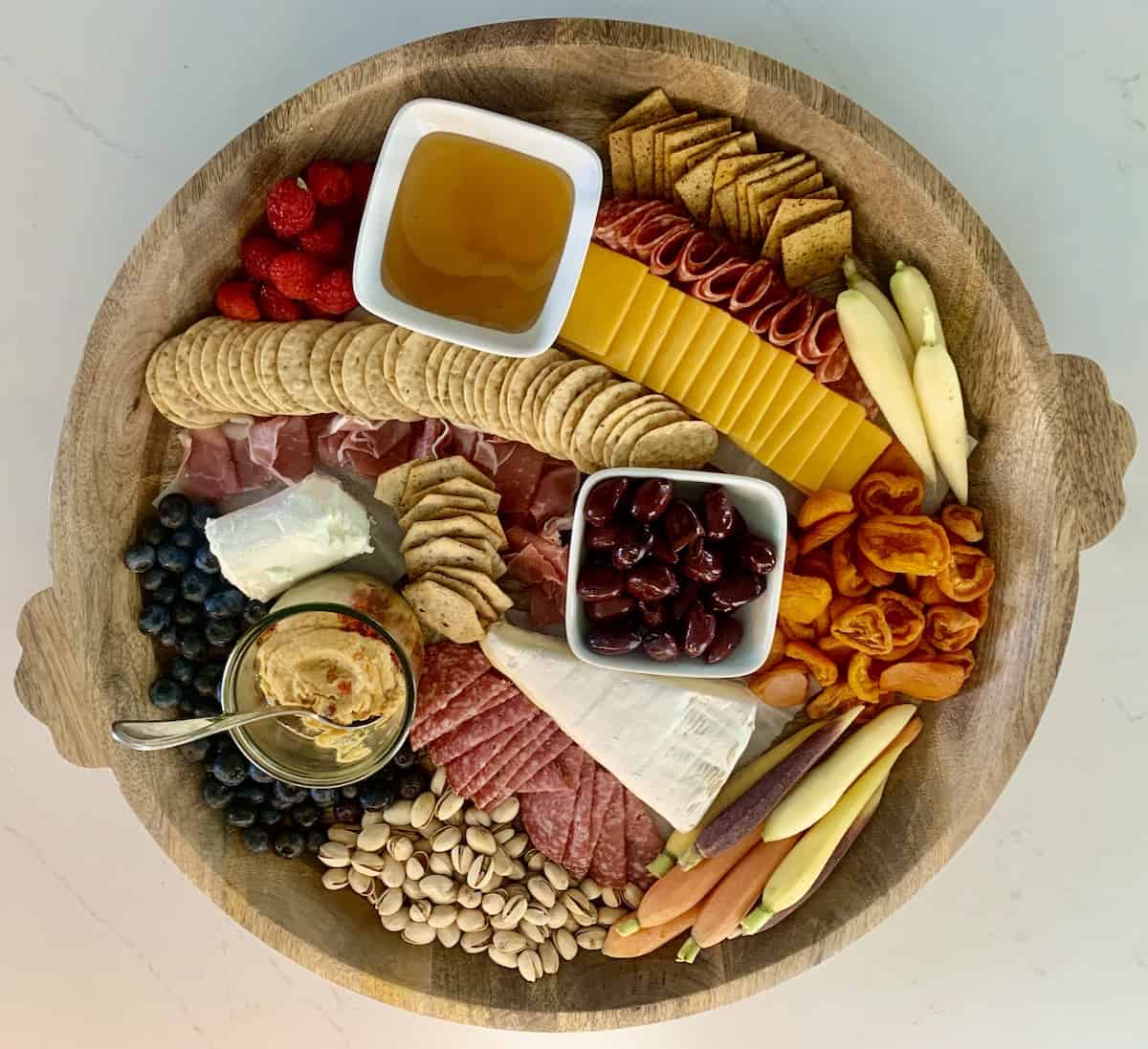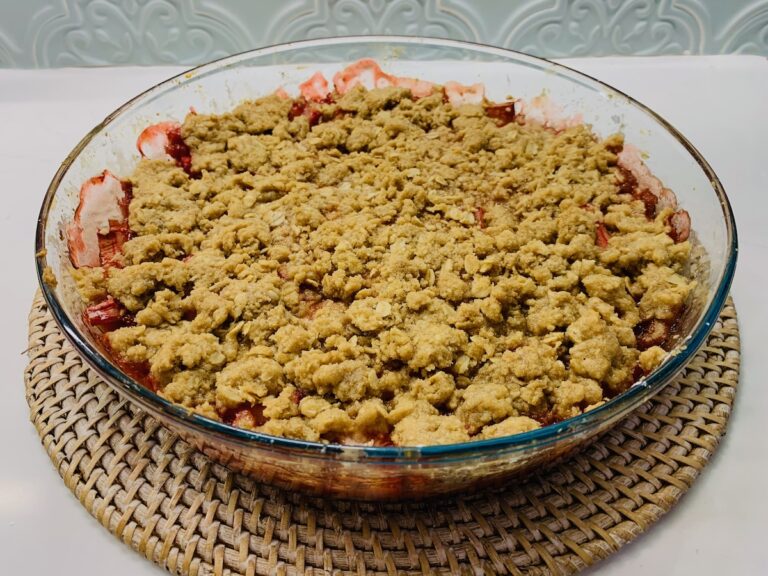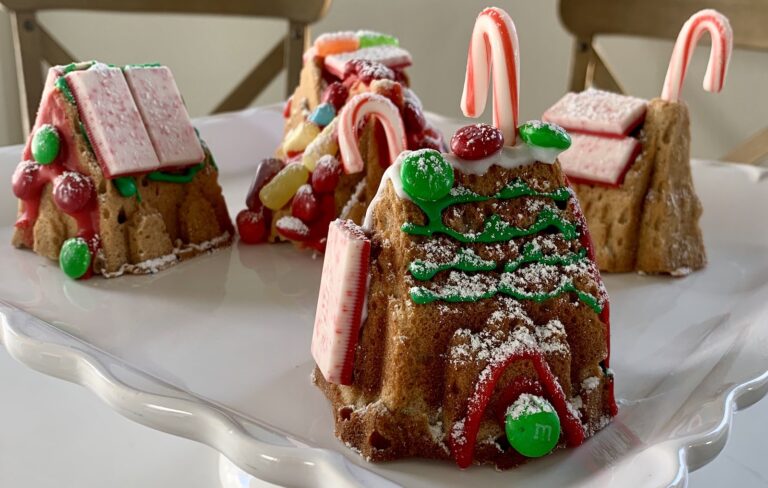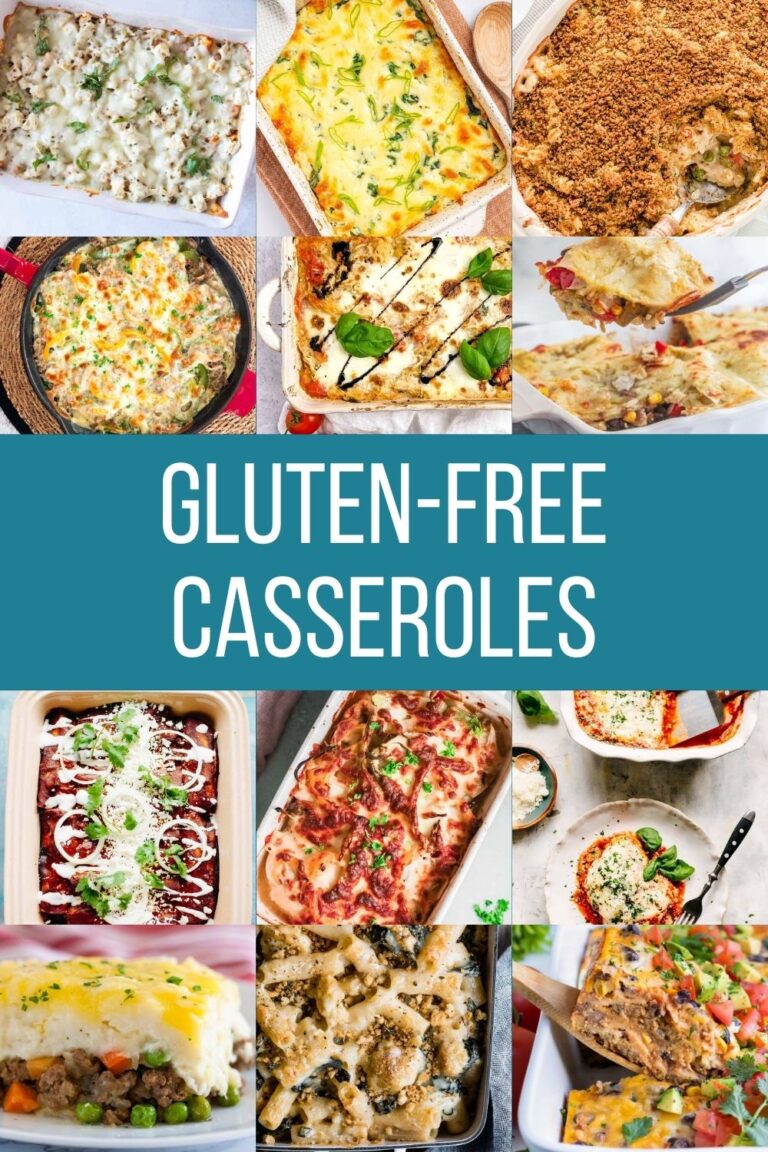How to Make an EASY Gluten-Free Charcuterie Board
Don’t be intimidated by the fancy name or beautiful Instagram pics. Making a gluten-free charcuterie is much easier than you think.
The magic is in the simplicity. It helps that you are constrained only by the canvas (serving board) you select. Within that boundary, it is very easy to create an attractive presentation with a variety of meats, cheeses, and delicious embellishments.
The result is a masterpiece where sweet, savory, salty, soft, firm, crunchy, delicate, rich, and fragrant foods combine into a feast for the mouth and eyes.
I’ll walk you through choosing ingredients, keeping it all gluten-free, and some tips for laying out your goodies to create a beautiful charcuterie board.
Some of the links on this post are affiliate links. To learn more, visit our Disclosures.
What Is Charcuterie?
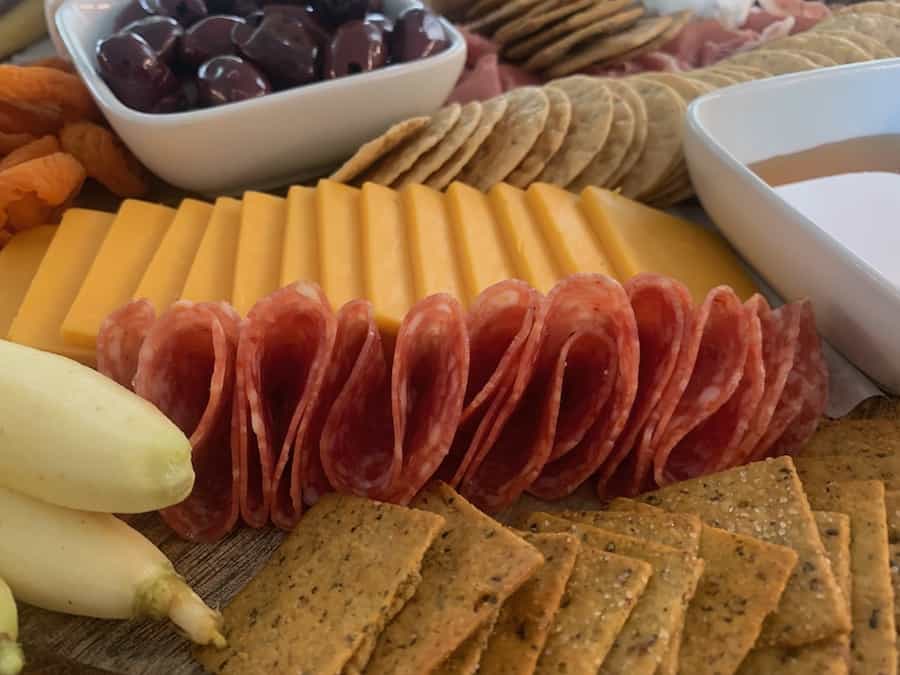
In French, charcuterie means “pork butcher shop” or the “cured pork products” sold there.
It is commonly understood to be a serving platter of a variety of meats and accompaniments, which will be our focus in this how-to guide.
This French term is now very loosely used to describe the trend of any serving tray or board packed full of a variety of food items with a focus on presentation. Breakfast charcuterie, Valentine’s charcuterie, Halloween charcuterie, dessert charcuterie, candy charcuterie.. the options are endless. Depending on the theme, pork may not even make an appearance.
Once you have the basic charcuterie board process down, you may just be inspired to make the modern version tweaked to match every occasion. I’m finding myself throwing little parties, just to have an excuse to make themed “charcuterie” boards.
Gluten-Free Ingredients
Meat, cheese, fruits, veggies, jams, most dips, and nuts are naturally gluten-free. Of course, always check labels to verify there are no gluten-containing additives.
Some products, like nuts, are more susceptible to cross-contamination. I look for voluntary “may contain” statements” on labels, and do not buy products that “may contain wheat”. You can also buy safe, labeled gluten-free nuts on Nuts.com.
When in doubt, keep it simple. Olives with lots of ingredients or flavored nuts from unfamiliar manufacturers have a chance of gluten ingredients or gluten cross-contact unless the label states otherwise. There is no shortage of excellent options with simple ingredients. Your finished, packed-full board will offer such a variety of colors and flavors that it isn’t necessary for every single ingredient to do so on its own.
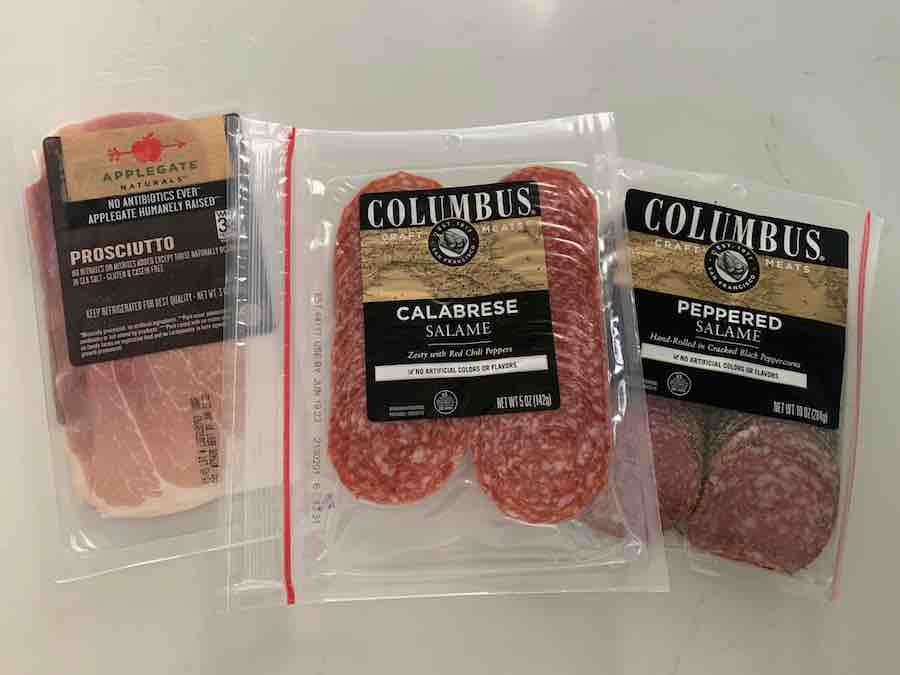
Meats (3-4 varieties)
True to the name charcuterie, I generally stick with pork products. Uncured, nitrate-free pork products last at room temperature for two hours, which is great for the grazing nature of a charcuterie tray. Cured meats last much longer. Check the package for details on each particular meat.
Stick to prepackaged meat products to avoid cross-contamination in the grocery store deli, where fresh meat and bread can be sliced on the same equipment.
Many brands take the extra step of identifying their deli meats as gluten-free. Popular and easy-to-find brands include Applegate, Boar’s Head, Columbus, and Dietz & Watson. Always check the package for the most up-to-date gluten-free status of any product.
- Genoa salami
- Peppered salami
- Prosciutto
- Pepperoni
- Soppressata
- Black Forest ham
- Antipasto Sampler: an easy way to get several varieties in one package
- Small sausages
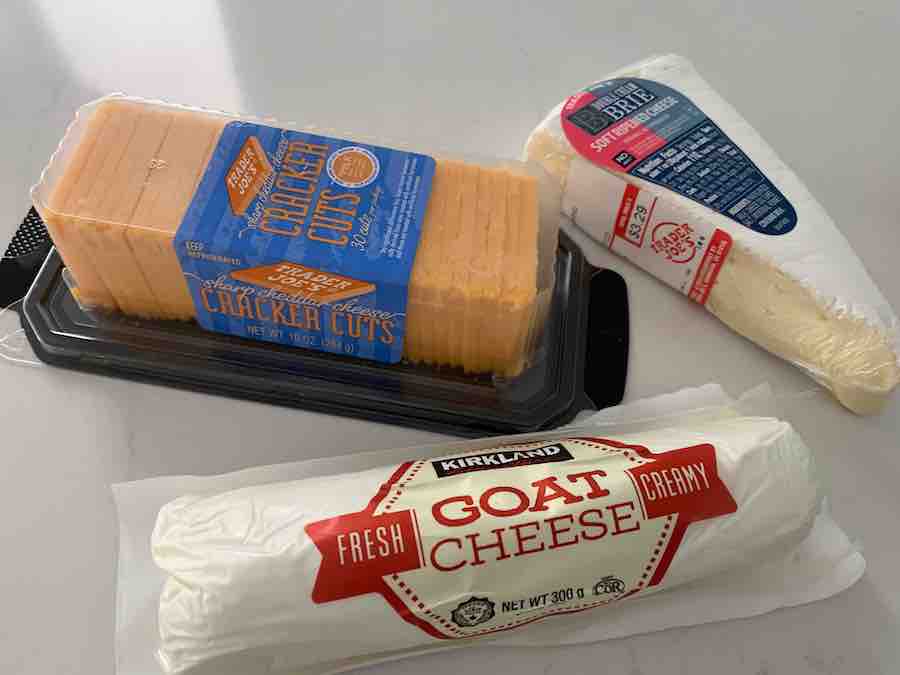
Cheeses (3-4 varieties)
When selecting your cheeses, choose a mix of soft and hard cheeses, aged and mild. Consider a variety of colors and shapes, such as rounds, wedges, cubes, and slices.
In addition to variety, think about your guests’ preferences. Are they adventurous or do they prefer familiarity? Maybe try one new, complex cheese and pair it with more common cheeses.
For today’s board, I “played it safe” with brie, goat cheese, and sharp cheddar. Even though two of the cheeses were soft, I was considering the crowd. At least two guests absolutely love brie. Goat cheese is my personal favorite. And I knew that the kids would eat cheddar.
While most cheese is naturally gluten-free, it rarely carries a gluten-free claim. Beyond Celiac has a helpful article on cheese, addressing many varieties. The bottom line summary of the article is that most cheese is gluten-free, but check the ingredients on the package.
- Goat cheese
- Brie
- Pepper jack
- Aged gouda
- Gruyere
- Parmesan Reggiano
- Pecorino
- Fresh mozzarella
- Kid-friendly options: string cheese, cheddar cheese cubes, and Babybel cheese
- Dairy-free cheese or vegan cheese
Crackers/Bread (2-3 varieties)
Traditional bread and crackers are full of gluten. While most other items on a charcuterie board are naturally gluten-free, the carrier (crackers, bread, etc.) for all the other food items will need to be specifically labeled gluten-free.
If you are making this board for some with a medically necessary gluten-free diet, like folks with celiac disease (that’s me) or gluten intolerance, please keep it completely gluten-free. The nature of a shared board where guests keep coming back makes cross-contamination incredibly likely.
If you decide to offer gluten-containing crackers or bread, please keep them on a separate tray and allow your gluten-free guests to go first and load up a plate with everything they need for the evening. They will not be able to make a second pass at the charcuterie board once it has been potentially contaminated with gluten crumbs.
There are so many great options when choosing the best gluten-free crackers and carriers for your charcuterie board. While I have a weakness for flavored crackers, I usually also include plain crackers, allowing the other ingredients to shine.
- Gluten-free crackers:
- Trader Joe’s Gluten-Free Savory Thin Crackers
- Simple Mills (my personal favorite!): Almond Flour Rosemary Crackers, Almond Flour Sundried Tomato Crackers, Seed Flour Crackers
- Gluten-free pita chips
- Gluten-free blue corn tortilla chips
- Gluten-free pretzels
- Gluten-free french bread: sliced and toasted
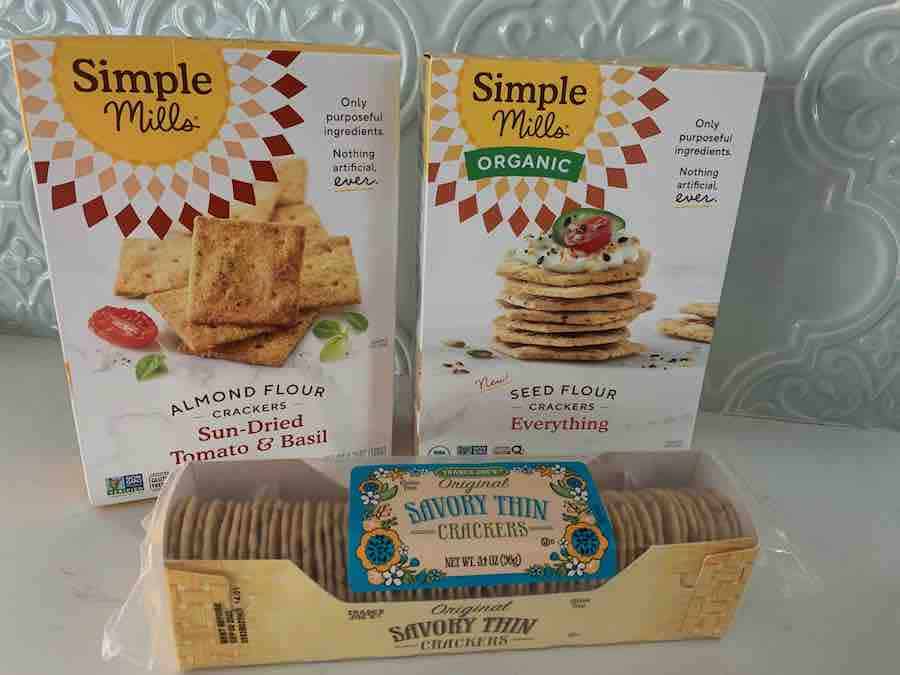
Today, I used three different shaped crackers: round Trader Joe’s Gluten-Free Savory Thin Crackers, square Simple Mills Sundried Tomato Crackers, and hexagon Simple Mills Seed Flour Crackers, which provide an interesting mix of shapes and flavor profiles.
A note on gluten-free crackers. They don’t hold together like wheat-containing crackers. This often leaves you with a lot of broken crackers in the box. As broken crackers do not make great carriers for meat and cheese and presentation is key, I only use whole crackers on the board. Here’s how I minimize waste:
- Buy crackers in-store rather than online to cut down on breakage during shipping.
- Consider Trader Joe’s Gluten-Free Savory Thin Crackers. They are packaged neatly and tightly in a box, minimizing breakage. Because of the clear packaging, you can also see inside and choose a package with the fewest broken crackers. They are incredibly affordable at under $2 a box.
- I place the whole crackers on the tray and return the broken crackers to the box for my family to eat later.
- Cracker crumbles can be repurposed as breadcrumbs in gluten-free meatballs and meatloaf or to coat chicken.
Dips: Savory & Sweet (2-3 varieties)
Include your favorite dips and spreads. Guests can add hummus to their crackers, dip vegetables in tzatziki, drizzle honey on goat cheese, and mix and match to their hearts’ content.
For a hot dip, try this Spinach Artichoke Dip, perfect for dipping chips, crackers, or veggies.
Get inspired with countless hot and cold dips in my Super Bowl Dip Roundup and Gluten-Free Appetizer Collection.
Fruit (2-3 varieties)
Sweet fresh and dried fruits balance out the other savory and salty items on your charcuterie tray. Fresh fruits especially add color to your board.
Fruit can help you create themed charcuterie boards: red strawberries and raspberries for a Valentine’s Day dessert charcuterie, apples with caramel dip for a fall charcuterie, and dried cranberries on a Christmas board.
- Sliced apples and pears: Soak in lemon juice or pineapple juice to prevent browning. I recommend pineapple juice for sweetness.
- Fresh berries: blueberries, blackberries, strawberries, raspberries
- Halved pomegranates
- Grapes
- Sliced mango
- Cubed melon
- Dried fruit: apricots, mango, cranberries, figs, dates
- Candied cranberries
- Candied orange slices (I find these at Trader Joe’s)
Vegetables or Brined Fruits/Veggies (1-2 varieties)
While vegetables are not absolutely necessary, they add a nice crunchy option to your board to balance out the soft cheeses and fruits. And brined foods provide a salty flavor that compliments the other items on your board. Certainly, pickles check both boxes, crunchy and salty! Personally, I’m partial to olives, so you see them on today’s board.
- Pickles
- Cornichons (French, small, tart & sweet pickles)
- Olives
- Marinated artichoke hearts
- Carrots
- Jicama
Embellishments (1-2 varieties)
Now, we’re just having fun. These embellishments are optional, but adding one or two can really give your board character. I love a section of in-shell, mixed nuts on a fall harvest charcuterie display. And who doesn’t love chocolate?
- Gluten-free chocolate
- Herbs: sprig of rosemary, thyme
- Lavender
- Nuts: pecans, pistachios, walnuts, almonds (shelled or in-shell)
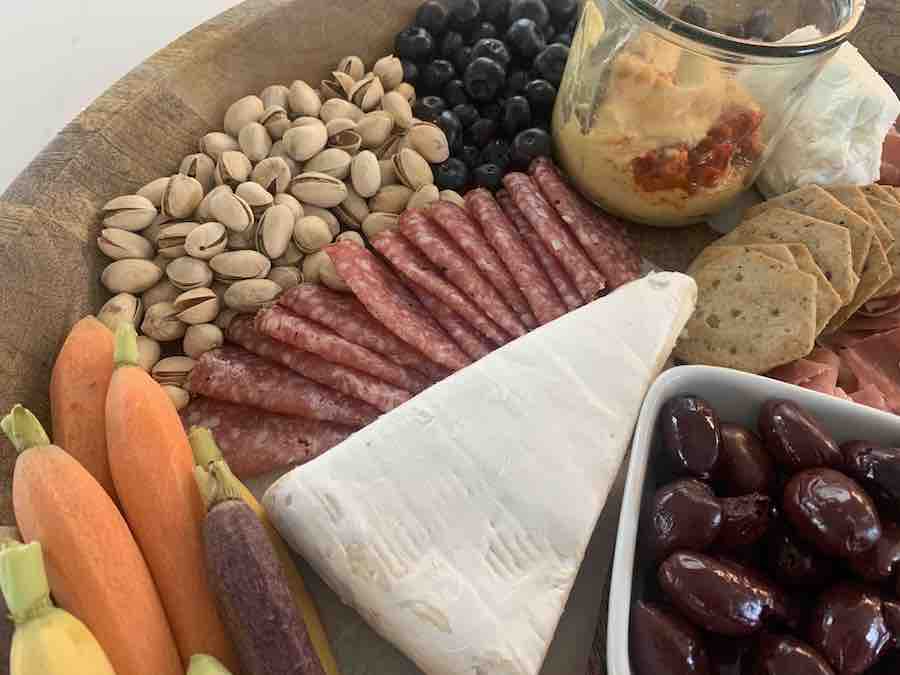
How Much Food Do I Need?
How Many Varieties of Each Category?
Variety is key to a charcuterie tray. How much variety depends on the size of the crowd and the matching size of your board.
This recipe and the tray in the photos were created for 10 guests. The recommendations next to each ingredient category listed above are also based on serving 10 guests. But they are flexible guidelines. You can go up or down based on the number of people.
For a small charcuterie board for two or four people, 1-2 varieties of meats, cheeses, and crackers, along with just one of all of the other categories is perfect!
To make a large charcuterie for 20+ guests, add even more varieties under each category to keep the tray visually interesting.
| 2-4 people | 10-12 people | 20+ people | |
| Meats: | 1-2 varieties | 3-4 varieties | 4-7 varieties |
| Cheeses: | 1-2 varieties | 3-4 varieties | 5-7 varieties |
| Crackers/Bread: | 1-2 varieties | 2-3 varieties | 3-4 varieties |
| Dips: | 1 | 2-3 varieties | 3-4 varieties |
| Fruits: | 1 | 2-3 varieties | 3-5 varieties |
| Vegetables (& brined food): | 1 | 1-2 varieties | 2-4 varieties |
| Embellishments: | 1 | 1-2 varieties | 2-4 varieties |
How Much Will Each Person Eat?
For a grazing board that lasts a couple of hours… picture Oscars and book clubs… estimate 2-3 ounces of meat per person, 2-3 ounces of cheese per person, and enough of the other items for each person to grab 2-3 bites or pieces of everything.
For an appetizer before a full meal, reduce those recommended amounts by half.
Supplies
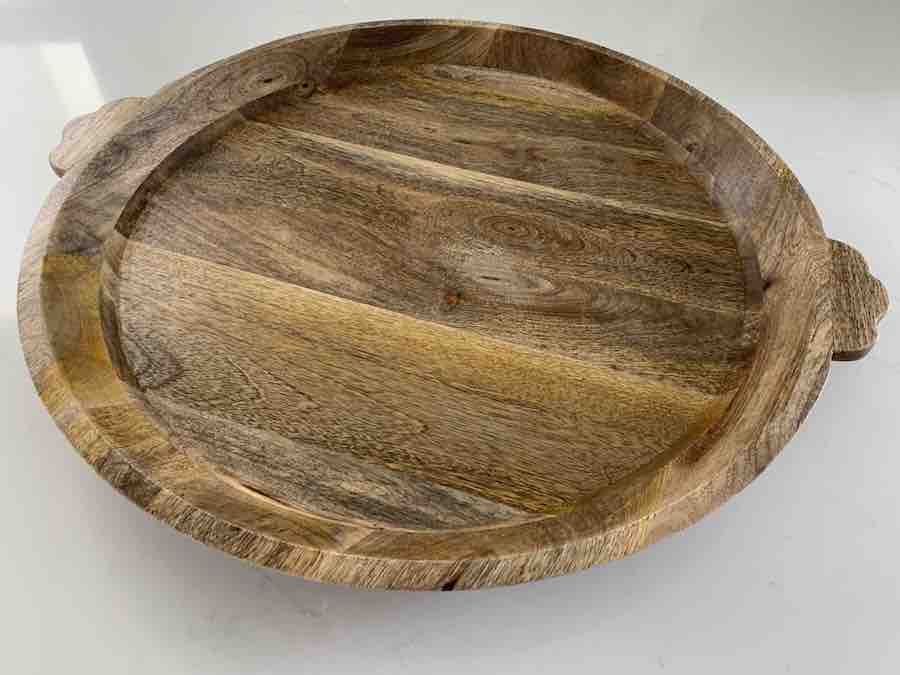
Snack Board
When choosing the base of your charcuterie display, There are so many great options, large and small.
Serving trays, wooden cutting boards, slate boards, storage trays, cake stands, mirrors, and large platters are all great options.
I used a gorgeous, round mango wood serving tray from Target to make the gluten-free charcuterie board seen in this post. The inside diameter (if you drew a line through the middle of the circle) is approximately 17″. It’s the perfect size for serving 10 guests, per the recipe.
To serve 10 guests with a square or rectangle board, a 15″ square board or 12″x18″ rectangle serving platter would both be great options.
If you don’t have a large enough board, use a collection of a few smaller boards. Together they’ll make a big impact.
Small Condiment Bowls
Small bowls, tiny platters cups, and glasses add key focal points to your board and are ideal for serving dips and containing items like olives and their liquids.
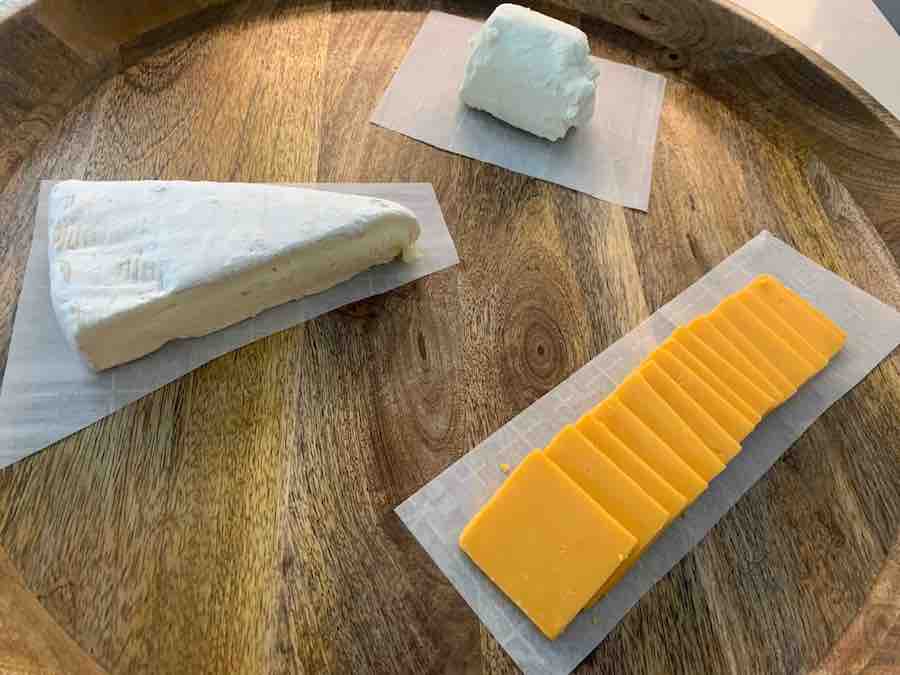
Parchment Paper
Parchment paper or wax paper is completely optional, but it has several benefits:
- It makes cleaning up easy.
- It protects wood if you opt for using a wooden board.
- It transforms a non-food-safe surface, such as a decorative tray, into a food-safe surface.
- It freshens up an unattractive surface, like a baking sheet or an old cutting board.
You can use it to cover your entire board, or separately under individual foods that tend to get messy.
Serving Utensils
Make sure each item has its own serving utensil. It prevents flavors from inadvertently being mixed when guests have to use one knife for several different kinds of cheese or one spoon for several dips.
- Cheese knives
- Appetizer spoons, forks, and tongs
- Honey dipper: optional if including honey on your board, but a small spoon works, too!
Small Plates & Napkins
While the board gets plenty of serving utensils, charcuterie is best enjoyed as finger food. Plates and napkins are all your guests need to enjoy this beautiful array of goodies.
Instead of a traditional charcuterie board, you could make these individual charcuterie cups. You’ll just need to pick up appetizer skewers and plastic cups, or use glassware you have on hand.
Charcuterie on a Budget
Shop your pantry! Use items you have on hand. Honey, jams, and nuts may already be in your pantry.
You don’t need special supplies. Do you have a decorative tray on your dresser? A giant cutting board? Or even a baking sheet? Any of those can be covered with a sheet of parchment paper and work perfectly as a cutting board. If you don’t own fancy bowls to serve dips, use small juice glasses, pretty mugs/cups, or Pyrex round microwave containers… and mix and match.
Meats and cheeses can be pricey. Pick up less expensive options at Target, Aldi, or Trader Joe’s. If your budget allows, splurge on one fancy cheese or meat, but balance it with something less expensive like $3 cheddar cheese cubes.
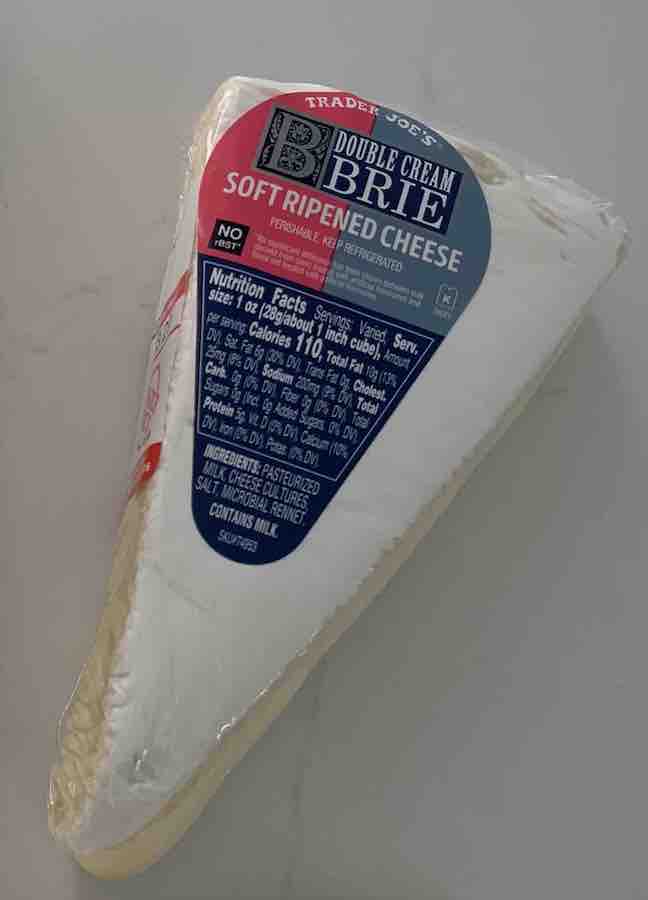
We are accustomed to gluten-free being more expensive. But most items on your board will not need to be pricey, gluten-free packaged products. Almost everything on this charcuterie ingredient list is naturally gluten-free… of course, always check labels for unusual ingredients, flavors, and cross-contamination.
The exception is the bread and crackers. To save money in this category, Trader Joe’s sells very affordable gluten-free rice crackers.
Choose in-season fruits and veggies to save money. Use a variety of tart and sweet apples and pears in different colors in the fall. Be generous with fresh fruits and berries in spring and summer. And balance out the board with more brined veggies, nuts, dried fruits, and leaner sections of fresh fruit in winter.
Remember what makes the charcuterie so beautiful is the presentation of a variety of colors and forms. What makes it taste good, is the combination of textures and flavors. Each individual item does not need to be expensive or even particularly interesting on its own.
Step-by-Step Directions
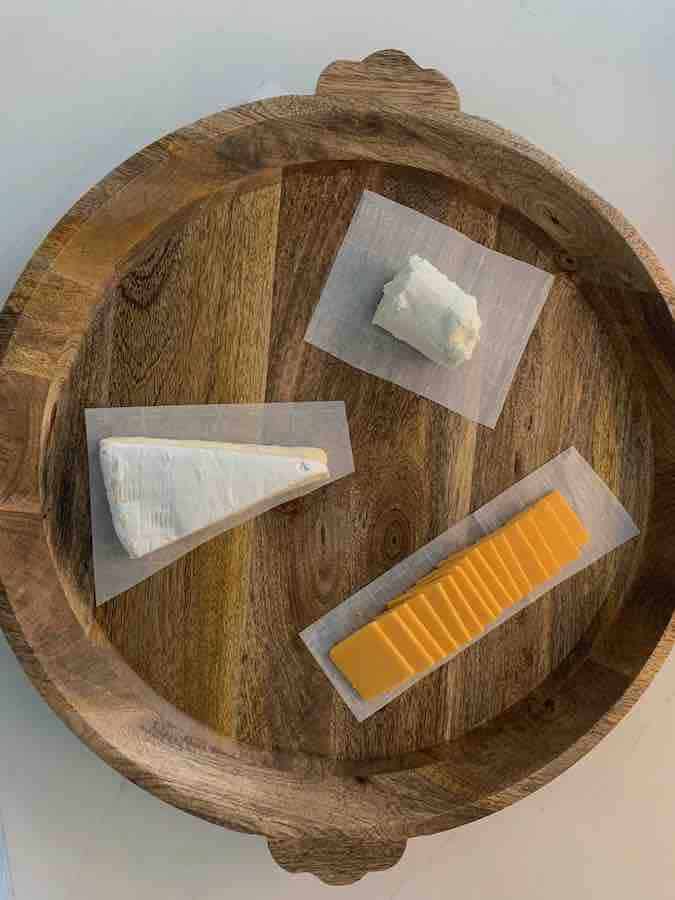
Arrange the cheeses in separate areas of your board.
Even though it’s technically a meat tray, cheese is the star. Your cheese selection adds texture, flavor, and interesting shapes to your board.
I prefer an odd number of cheeses on the board for balance. Stagger the cheese along the board, giving each cheese its own distinct space away from the other cheeses. Aside from being more visually appealing, it prevents the mingling of each cheese’s distinct flavors.
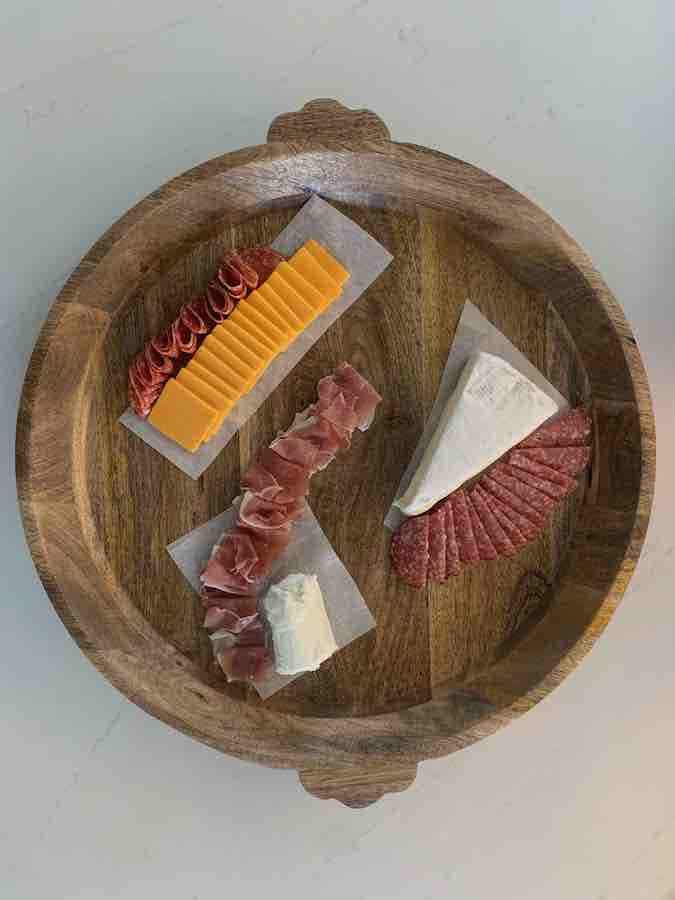
Fold your charcuterie selection (meats) in halves or quarters, and fan them out around the cheeses.
For an easy presentation, fold the salami in half and fan it out along the tray. Or fold it in quarters and stand it up in a row for a more three-dimensional appearance. Initially, the salami may resist taking a new form, but it quickly yields to its new shape as you apply pressure with your fingers and stack it with the weight of the other salami slices. As you fill the board, other items will help the salami stay in place.
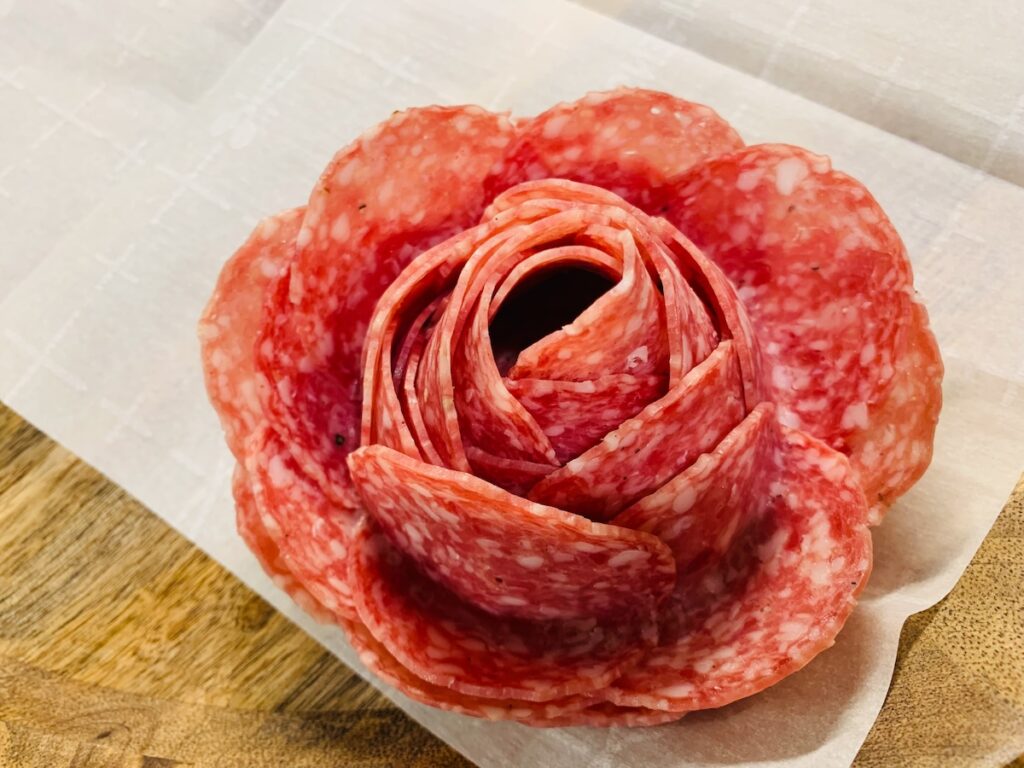
If you want to go all out, follow this simple tutorial for a salami rose that can serve as the focal point of your board.
For larger slices of meat, such as prosciutto, cut each slice in half lengthwise. Gently lay each half-slice of prosciutto on the board, layering it back and forth like a ribbon. It will be easy for guests to grab just one piece.
Like the salami, you can go all out, and make adorable prosciutto roses. It’s a lovely touch, but absolutely not necessary. Your charcuterie display will be stunning with or without the extra effort. If you do decide to spend the time on decorative elements, I recommend prepping them ahead of time and storing them in the fridge until you are ready to assemble your board.
Smaller pieces of meat, like pepperoni, can simply be fanned out and spread across the platter, like a river. No need to make yourself crazy trying to fold tiny pepperoni circles.
Place a selection of meat by each cheese. If you think one particular meat will pair better with a type of cheese, put them next to each other.
Try to keep each meat variety separate from the other varieties, in its own distinct space. This allows guests to distinguish each meat as different. It also helps to create blocks and ribbons of different colors on your board, as the meat is often similar in color.
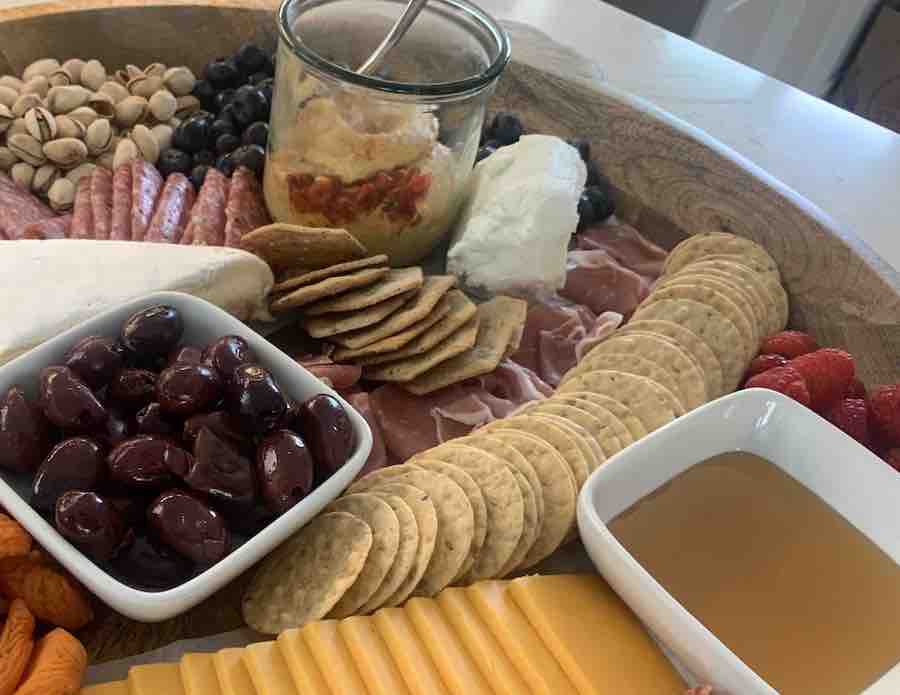
Add items you are serving in bowls or on platters.
Place the dips, like hummus, jam, olive oil, and honey, in small dipping bowls. Include a serving spoon with each dip, to prevent guests from inadvertently mixing flavors.
Any items with liquid that could spread onto other items should be placed in a small bowl or platter.
Be creative and use what you have. A glass mug makes a beautiful honey container. A tiny appetizer plate can hold a collection of pickles.
Once you’ve filled your small bowls, place them around the board. Visually, it is ideal to give each dipping bowl its own area on the board, separate from the other dipping bowls. Imagine you are placing the bowls on an empty board, and stagger them around the space, just as you did with the cheeses.
Consider color. Place orange hummus dip next to white goat cheese.
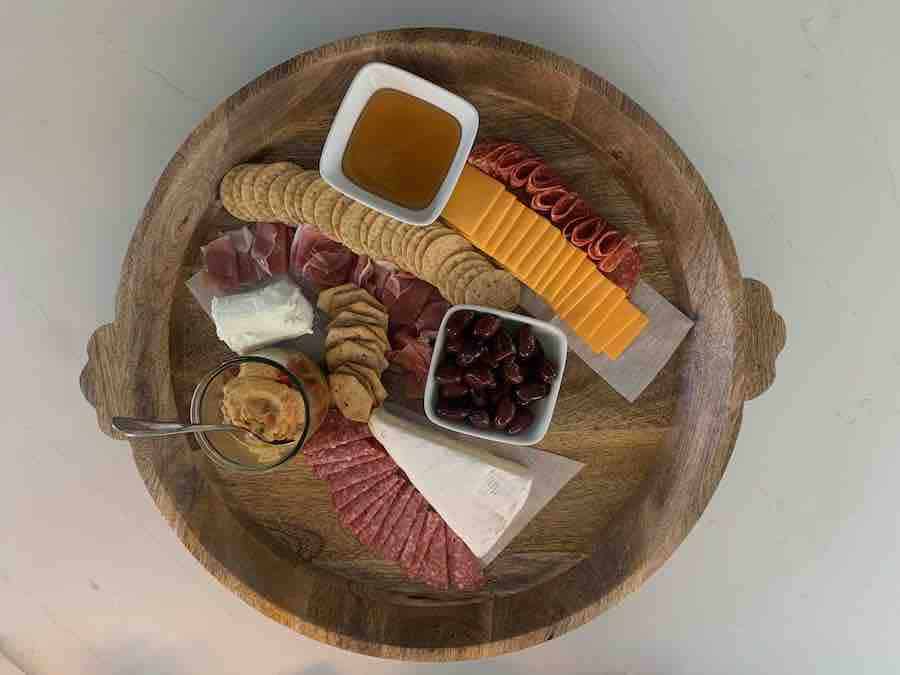
Arrange crackers around the board.
Look at your board, and identify where there is still space next to each grouping of meat and cheese. Fan out crackers or tuck stacks of them into those available spaces. Like the meats and cheeses, keep each variety of crackers separate from the others.
Think about which crackers might pair best with each meat or cheese combination, and place them together as a subtle suggestion to guests.
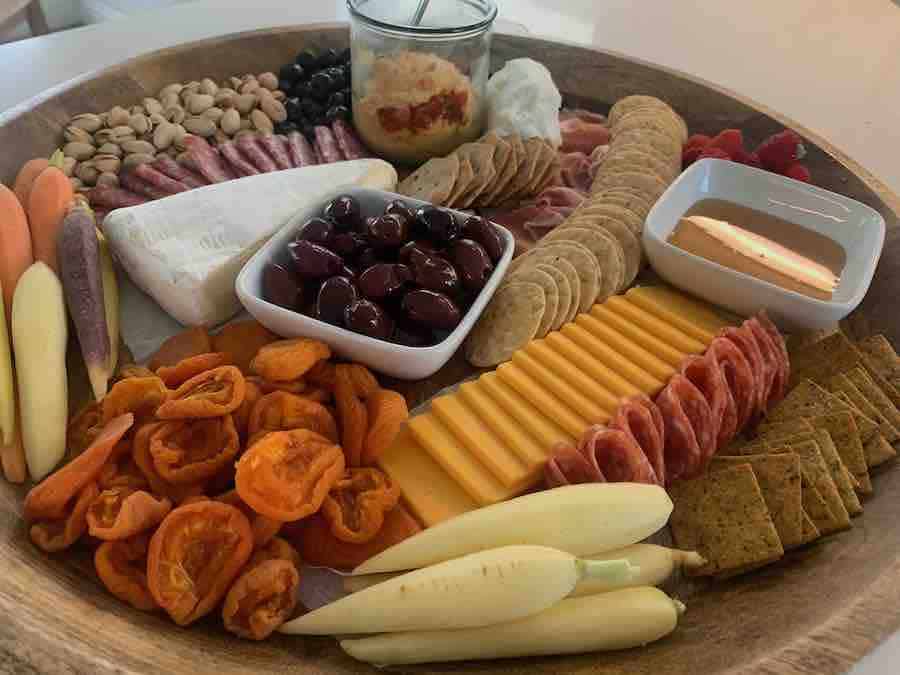
Fill in spaces with fruits and vegetables.
You’ll see large sections still open on the board. Begin to fill in those open spaces with fruits, vegetables, and any brined foods that are not already in bowls on the platter.
This step is all about the visual impact. Think about color as you place green pickles, orange cantaloupe, and red berries throughout your board.
If you can’t find just the right size space, nudge existing items around the board a bit until they look how you want. Nothing is glued down!
It’s also perfectly lovely to have smaller groupings of raspberries or another colorful item in two or three places around the board.
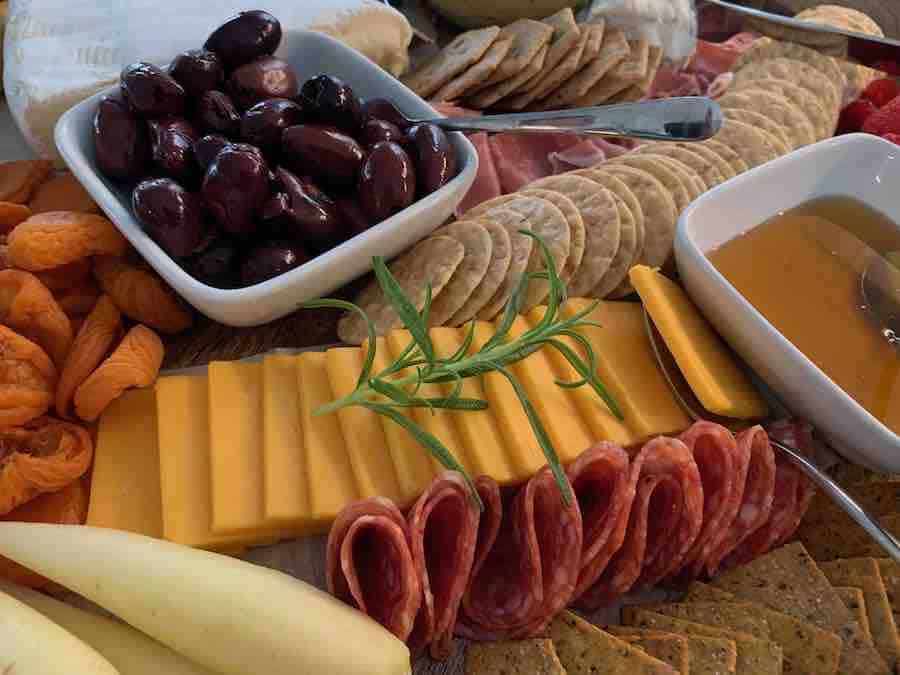
Finish with embellishments.
Add the embellishments, such as nuts and chocolate in the remaining open spaces on the board. Again, consider color. For example, place dark chocolate next to red strawberries rather than dark blueberries.
Finish by adding optional fresh herbs for scent and decoration. Make sure every item has its own serving utensil.
Voila! You’ve done it. It really was easy. Unless you went down the route of salami and prosciutto roses, the process took about 30 minutes. And it will be even faster and easier next time. Before you know it, you’ll be looking for an excuse to make another charcuterie board!
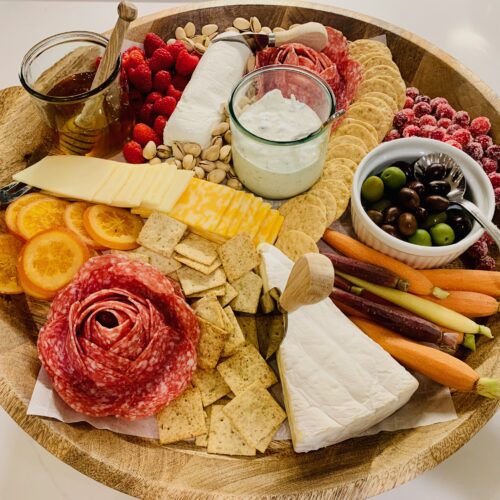
Gluten-Free Charcuterie Recipe
Ingredients
- 3-4 varieties of meat: genoa salami, peppered salami, prosciutto, pepperoni, soppressata, black forest ham, antipasto sampler, small sausages
- 3-4 varieties of cheese: goat cheese, brie, parmesan, pepper jack, aged gouda, gruyere, pecorino, fresh mozzarella, kid-friendly cheeses (string cheese, cheddar cheese cubes, Babybel), dairy-free, vegan
- 2-3 varieties of gluten-free bread/crackers: rice crackers, almond crackers, seed crackers, pita chips, corn chips, pretzels, french bread
- 2-3 varieties of dips: hummus, tzatziki, tapenade, honey, jam
- 2-3 varieties of fruit: fresh (sliced apples, pears, mangos, fresh berries, pomegranates, grapes) and dried (apricots, mango, cranberries, figs, dates)
- 1-2 varieties of vegetables (or brined fruits/vegetables): pickles, cornichons, olives, marinated artichoke hearts, carrots, jicama
- 1-2 varieties of embellishments: gluten-free chocolate, rosemary, thyme, lavender, nuts
Instructions
- Arrange the cheeses in separate areas of your board.
- Fold your charcuterie selection (meats) in halves or quarters, and fan them out around the cheeses.
- Add items you are serving in bowls or on platters (such as dips, jams, and olives).
- Arrange crackers around the board.
- Fill in spaces with fruits and vegetables (including brined foods).
- Finish with embellishments, such as nuts, chocolates, and decorative herbs.

